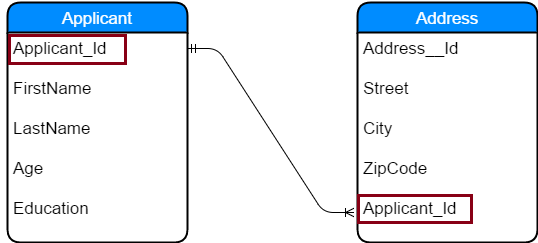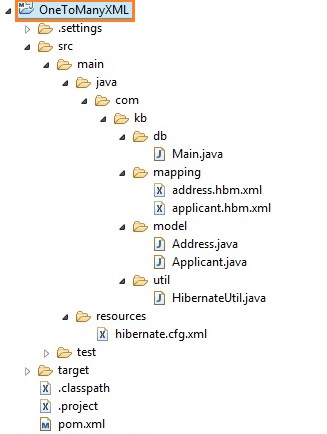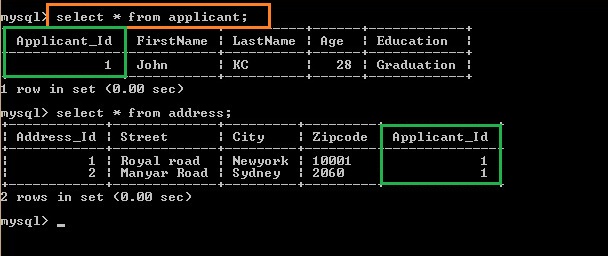One To Many Mapping XML Mapping in Hibernate
Let us understand about One to Many XML Mapping in Hibernate
In this article, let’s discuss about Bidirectional one to Many relation mapping in Hibernate using XML
In this relation mapping, one object of a class is associated with multiple objects of another class.
In other words
One record of a table is associated with multiple records of another table.
In this mapping primary key of One side will become a foreign key in Many side
Example:
Consider Applicant and Address
One Applicant can have have multiple addresses like Permanent address and Current address.
Relation looks as below

As shown in the above ER diagram,Relation between Applicant and Address is One To Many.
Address_Id is the primary key for Address table
Applicant_Id is the primary key for Applicant table
We can see that Applicant_Id which is the primary key at One side(Applicant) has become the Foreign key on the Many side(Address).
Step 1
Create hibernate project
Please refer Hibernate setup in eclipse article on how to do it.
Project structure

Step 2
Update pom.xml with Hibernate and Mysql dependencies
- <project xmlns="http://maven.apache.org/POM/4.0.0" xmlns:xsi="http://www.w3.org/2001/XMLSchema-instance"
- xsi:schemaLocation="http://maven.apache.org/POM/4.0.0 http://maven.apache.org/xsd/maven-4.0.0.xsd">
- <modelVersion>4.0.0</modelVersion>
- <groupId>OneToManyXML</groupId>
- <artifactId>OneToManyXML</artifactId>
- <version>0.0.1-SNAPSHOT</version>
- <packaging>jar</packaging>
- <name>OneToManyXML</name>
- <url>http://maven.apache.org</url>
- <properties>
- <project.build.sourceEncoding>UTF-8</project.build.sourceEncoding>
- </properties>
- <dependencies>
- <dependency>
- <groupId>junit</groupId>
- <artifactId>junit</artifactId>
- <version>3.8.1</version>
- <scope>test</scope>
- </dependency>
- <!-- https://mvnrepository.com/artifact/org.hibernate/hibernate-core -->
- <dependency>
- <groupId>org.hibernate</groupId>
- <artifactId>hibernate-core</artifactId>
- <version>5.2.6.Final</version>
- </dependency>
- <!-- https://mvnrepository.com/artifact/mysql/mysql-connector-java -->
- <dependency>
- <groupId>mysql</groupId>
- <artifactId>mysql-connector-java</artifactId>
- <version>6.0.5</version>
- </dependency>
- </dependencies>
- </project>
<project xmlns="http://maven.apache.org/POM/4.0.0" xmlns:xsi="http://www.w3.org/2001/XMLSchema-instance"
xsi:schemaLocation="http://maven.apache.org/POM/4.0.0 http://maven.apache.org/xsd/maven-4.0.0.xsd">
<modelVersion>4.0.0</modelVersion>
<groupId>OneToManyXML</groupId>
<artifactId>OneToManyXML</artifactId>
<version>0.0.1-SNAPSHOT</version>
<packaging>jar</packaging>
<name>OneToManyXML</name>
<url>http://maven.apache.org</url>
<properties>
<project.build.sourceEncoding>UTF-8</project.build.sourceEncoding>
</properties>
<dependencies>
<dependency>
<groupId>junit</groupId>
<artifactId>junit</artifactId>
<version>3.8.1</version>
<scope>test</scope>
</dependency>
<!-- https://mvnrepository.com/artifact/org.hibernate/hibernate-core -->
<dependency>
<groupId>org.hibernate</groupId>
<artifactId>hibernate-core</artifactId>
<version>5.2.6.Final</version>
</dependency>
<!-- https://mvnrepository.com/artifact/mysql/mysql-connector-java -->
<dependency>
<groupId>mysql</groupId>
<artifactId>mysql-connector-java</artifactId>
<version>6.0.5</version>
</dependency>
</dependencies>
</project>
Step 3
Create Applicant class
- package com.kb.model;
- import java.util.Set;
- public class Applicant {
- private int applicantId;
- private String firstName;
- private String lastName;
- private int age;
- private String education;
- private Set<Address> addresses;
- public int getApplicantId() {
- return applicantId;
- }
- public void setApplicantId(int applicantId) {
- this.applicantId = applicantId;
- }
- public String getFirstName() {
- return firstName;
- }
- public void setFirstName(String firstName) {
- this.firstName = firstName;
- }
- public String getLastName() {
- return lastName;
- }
- public void setLastName(String lastName) {
- this.lastName = lastName;
- }
- public int getAge() {
- return age;
- }
- public void setAge(int age) {
- this.age = age;
- }
- public String getEducation() {
- return education;
- }
- public void setEducation(String education) {
- this.education = education;
- }
- public Set<Address> getAddresses() {
- return addresses;
- }
- public void setAddresses(Set<Address> addresses) {
- this.addresses = addresses;
- }
- }
package com.kb.model;
import java.util.Set;
public class Applicant {
private int applicantId;
private String firstName;
private String lastName;
private int age;
private String education;
private Set<Address> addresses;
public int getApplicantId() {
return applicantId;
}
public void setApplicantId(int applicantId) {
this.applicantId = applicantId;
}
public String getFirstName() {
return firstName;
}
public void setFirstName(String firstName) {
this.firstName = firstName;
}
public String getLastName() {
return lastName;
}
public void setLastName(String lastName) {
this.lastName = lastName;
}
public int getAge() {
return age;
}
public void setAge(int age) {
this.age = age;
}
public String getEducation() {
return education;
}
public void setEducation(String education) {
this.education = education;
}
public Set<Address> getAddresses() {
return addresses;
}
public void setAddresses(Set<Address> addresses) {
this.addresses = addresses;
}
}
We can see that we have added Set< Address> in Applicant class to maintain OneToMany relation.
Step 4
Create Address class
- package com.kb.model;
- public class Address {
- private int addressId;
- private String street;
- private String city;
- private String zipcode;
- private Applicant applicant;
- public int getAddressId() {
- return addressId;
- }
- public void setAddressId(int addressId) {
- this.addressId = addressId;
- }
- public String getStreet() {
- return street;
- }
- public void setStreet(String street) {
- this.street = street;
- }
- public String getCity() {
- return city;
- }
- public void setCity(String city) {
- this.city = city;
- }
- public String getZipcode() {
- return zipcode;
- }
- public void setZipcode(String zipcode) {
- this.zipcode = zipcode;
- }
- public Applicant getApplicant() {
- return applicant;
- }
- public void setApplicant(Applicant applicant) {
- this.applicant = applicant;
- }
- }
package com.kb.model;
public class Address {
private int addressId;
private String street;
private String city;
private String zipcode;
private Applicant applicant;
public int getAddressId() {
return addressId;
}
public void setAddressId(int addressId) {
this.addressId = addressId;
}
public String getStreet() {
return street;
}
public void setStreet(String street) {
this.street = street;
}
public String getCity() {
return city;
}
public void setCity(String city) {
this.city = city;
}
public String getZipcode() {
return zipcode;
}
public void setZipcode(String zipcode) {
this.zipcode = zipcode;
}
public Applicant getApplicant() {
return applicant;
}
public void setApplicant(Applicant applicant) {
this.applicant = applicant;
}
}
We can see that we have added Applicant in Address class to maintain other side of OneToMany relation which is ManyToOne.
Step 5
Create applicant.hbm.xml
- <?xml version='1.0' encoding='UTF-8'?>
- <!DOCTYPE hibernate-mapping PUBLIC
- "-//Hibernate/Hibernate Mapping DTD 3.0//EN"
- "http://hibernate.sourceforge.net/hibernate-mapping-3.0.dtd">
- <hibernate-mapping package="com.kb.model">
- <class name="Applicant" table="Applicant">
- <id name="applicantId" type="int">
- <column name="Applicant_Id"></column>
- <generator class="increment"></generator>
- </id>
- <property name="firstName" column="FirstName"></property>
- <property name="lastName" column="LastName"></property>
- <property name="age" type="int" column="Age"></property>
- <property name="education" column="Education"></property>
- <set name="addresses" table="Address"
- inverse="true" lazy="true" fetch="select">
- <key>
- <column name="Applicant_Id" not-null="true" />
- </key>
- <one-to-many class="Address" />
- </set>
- </class>
- </hibernate-mapping>
<?xml version='1.0' encoding='UTF-8'?>
<!DOCTYPE hibernate-mapping PUBLIC
"-//Hibernate/Hibernate Mapping DTD 3.0//EN"
"http://hibernate.sourceforge.net/hibernate-mapping-3.0.dtd">
<hibernate-mapping package="com.kb.model">
<class name="Applicant" table="Applicant">
<id name="applicantId" type="int">
<column name="Applicant_Id"></column>
<generator class="increment"></generator>
</id>
<property name="firstName" column="FirstName"></property>
<property name="lastName" column="LastName"></property>
<property name="age" type="int" column="Age"></property>
<property name="education" column="Education"></property>
<set name="addresses" table="Address"
inverse="true" lazy="true" fetch="select">
<key>
<column name="Applicant_Id" not-null="true" />
</key>
<one-to-many class="Address" />
</set>
</class>
</hibernate-mapping>
In this mapping file,We have defined the Table mapping for Applicant class.
We have specified Primary key as applicantId and generator class as “increment” for automatic primary key generation.
We have defined One to Many mapping with Address entity using < set > and < one-to-many > tag.
We have also provided lazy = true to achieve lazy loading
fetch = select to inform hibernate to generate separate select query while retrieving addresses
inverse = true indicates that Address is the relationship owner.
Step 6
Create address.hbm.xml
- <?xml version='1.0' encoding='UTF-8'?>
- <!DOCTYPE hibernate-mapping PUBLIC
- "-//Hibernate/Hibernate Mapping DTD 3.0//EN"
- "http://hibernate.sourceforge.net/hibernate-mapping-3.0.dtd">
- <hibernate-mapping package="com.kb.model">
- <class name="Address" table="Address">
- <id name="addressId" type="int">
- <column name="Address_Id" />
- <generator class="increment" />
- </id>
- <property name="street" column="Street" />
- <property name="city" column="City" />
- <property name="zipcode" column="Zipcode" />
- <many-to-one name="applicant" class="Applicant" fetch="select">
- <column name="Applicant_Id" not-null="true" />
- </many-to-one>
- </class>
- </hibernate-mapping>
<?xml version='1.0' encoding='UTF-8'?>
<!DOCTYPE hibernate-mapping PUBLIC
"-//Hibernate/Hibernate Mapping DTD 3.0//EN"
"http://hibernate.sourceforge.net/hibernate-mapping-3.0.dtd">
<hibernate-mapping package="com.kb.model">
<class name="Address" table="Address">
<id name="addressId" type="int">
<column name="Address_Id" />
<generator class="increment" />
</id>
<property name="street" column="Street" />
<property name="city" column="City" />
<property name="zipcode" column="Zipcode" />
<many-to-one name="applicant" class="Applicant" fetch="select">
<column name="Applicant_Id" not-null="true" />
</many-to-one>
</class>
</hibernate-mapping>
In this mapping file,We have defined the Table mapping for Address class.
We have specified Primary key as addressId and generator class as “increment”.
We have defined Many to One mapping with Applicant entity using < many-to-one > tag as in Many Addresses belongs to one Employee..
We have also provided fetch=select to inform hibernate to generate separate select query while retrieving Applicant(used for lazy loading)
Step 7
Create hibernate.cfg.xml
- <?xml version="1.0" encoding="UTF-8"?>
- <!DOCTYPE hibernate-configuration PUBLIC
- "-//Hibernate/Hibernate Configuration DTD 3.0//EN"
- "http://www.hibernate.org/dtd/hibernate-configuration-3.0.dtd">
- <hibernate-configuration>
- <session-factory>
- <!-- Database connection properties -->
- <property name="connection.driver_class">com.mysql.jdbc.Driver</property>
- <property name="connection.url">jdbc:mysql://localhost/javainsimpleway</property>
- <property name="connection.username">root</property>
- <property name="connection.password">root</property>
- <!-- JDBC connection pool (using the built-in) -->
- <property name="connection.pool_size">10</property>
- <!-- SQL dialect -->
- <property name="dialect">org.hibernate.dialect.MySQLDialect</property>
- <!-- Disable the second-level cache -->
- <property name="cache.provider_class">org.hibernate.cache.internal.NoCacheProvider</property>
- <!-- Echo all executed SQL to stdout -->
- <property name="show_sql">true</property>
- <!-- Format the generated Sql -->
- <property name="format_sql">true</property>
- <!-- Dont Drop and re-create the database schema on startup,Just update it -->
- <property name="hbm2ddl.auto">update</property>
- <mapping resource="com/kb/mapping/applicant.hbm.xml"/>
- <mapping resource="com/kb/mapping/address.hbm.xml"/>
- </session-factory>
- </hibernate-configuration>
<?xml version="1.0" encoding="UTF-8"?>
<!DOCTYPE hibernate-configuration PUBLIC
"-//Hibernate/Hibernate Configuration DTD 3.0//EN"
"http://www.hibernate.org/dtd/hibernate-configuration-3.0.dtd">
<hibernate-configuration>
<session-factory>
<!-- Database connection properties -->
<property name="connection.driver_class">com.mysql.jdbc.Driver</property>
<property name="connection.url">jdbc:mysql://localhost/javainsimpleway</property>
<property name="connection.username">root</property>
<property name="connection.password">root</property>
<!-- JDBC connection pool (using the built-in) -->
<property name="connection.pool_size">10</property>
<!-- SQL dialect -->
<property name="dialect">org.hibernate.dialect.MySQLDialect</property>
<!-- Disable the second-level cache -->
<property name="cache.provider_class">org.hibernate.cache.internal.NoCacheProvider</property>
<!-- Echo all executed SQL to stdout -->
<property name="show_sql">true</property>
<!-- Format the generated Sql -->
<property name="format_sql">true</property>
<!-- Dont Drop and re-create the database schema on startup,Just update it -->
<property name="hbm2ddl.auto">update</property>
<mapping resource="com/kb/mapping/applicant.hbm.xml"/>
<mapping resource="com/kb/mapping/address.hbm.xml"/>
</session-factory>
</hibernate-configuration>
We have defined all the database configuration in this file
hbm2ddl.auto property is defined in the config file which helps in automatic creation of tables in the database based on the mapping.
We have also provided the mapping xml file location using < mapping > tag.
Step 8
Create Hibernate util class
- package com.kb.util;
- import org.hibernate.SessionFactory;
- import org.hibernate.cfg.Configuration;
- public class HibernateUtil {
- private static final SessionFactory sessionFactory = buildSessionFactory();
- private static SessionFactory buildSessionFactory() {
- try {
- // Create the SessionFactory from hibernate.cfg.xml
- return new Configuration().configure().buildSessionFactory();
- } catch (Throwable ex) {
- // Make sure you log the exception to track it
- System.err.println("SessionFactory creation failed." + ex);
- throw new ExceptionInInitializerError(ex);
- }
- }
- public static SessionFactory getSessionFactory() {
- return sessionFactory;
- }
- public static void shutdown() {
- // Optional but can be used to Close caches and connection pools
- getSessionFactory().close();
- }
- }
package com.kb.util;
import org.hibernate.SessionFactory;
import org.hibernate.cfg.Configuration;
public class HibernateUtil {
private static final SessionFactory sessionFactory = buildSessionFactory();
private static SessionFactory buildSessionFactory() {
try {
// Create the SessionFactory from hibernate.cfg.xml
return new Configuration().configure().buildSessionFactory();
} catch (Throwable ex) {
// Make sure you log the exception to track it
System.err.println("SessionFactory creation failed." + ex);
throw new ExceptionInInitializerError(ex);
}
}
public static SessionFactory getSessionFactory() {
return sessionFactory;
}
public static void shutdown() {
// Optional but can be used to Close caches and connection pools
getSessionFactory().close();
}
}
Step 9
Create main class to interact with DB
- package com.kb.db;
- import org.hibernate.Session;
- import org.hibernate.SessionFactory;
- import org.hibernate.Transaction;
- import com.kb.model.Address;
- import com.kb.model.Applicant;
- import com.kb.util.HibernateUtil;
- public class Main {
- public static void main(String[] args) {
- // Get session factory using Hibernate Util class
- SessionFactory sf = HibernateUtil.getSessionFactory();
- // Get session from Sesson factory
- Session session = sf.openSession();
- // Begin transaction
- Transaction t = session.beginTransaction();
- //Create Applicant Model data
- Applicant applicant = new Applicant();
- applicant.setFirstName("John");
- applicant.setLastName("KC");
- applicant.setAge(28);
- applicant.setEducation("Graduation");
- //Create Passport Model data
- Address currentAdd = new Address();
- currentAdd.setStreet("Royal road");
- currentAdd.setCity("Newyork");
- currentAdd.setZipcode("10001");
- //Associate Applicant to current Address
- currentAdd.setApplicant(applicant);
- Address permanentAdd = new Address();
- permanentAdd.setStreet("Manyar Road");
- permanentAdd.setCity("Sydney");
- permanentAdd.setZipcode("2060");
- //Associate Applicant to permanent Address
- permanentAdd.setApplicant(applicant);
- session.persist(applicant);
- session.persist(currentAdd);
- session.persist(permanentAdd);
- // Commit the transaction and close the session
- t.commit();
- session.close();
- System.out.println("successfully persisted Applicant details");
- }
- }
package com.kb.db;
import org.hibernate.Session;
import org.hibernate.SessionFactory;
import org.hibernate.Transaction;
import com.kb.model.Address;
import com.kb.model.Applicant;
import com.kb.util.HibernateUtil;
public class Main {
public static void main(String[] args) {
// Get session factory using Hibernate Util class
SessionFactory sf = HibernateUtil.getSessionFactory();
// Get session from Sesson factory
Session session = sf.openSession();
// Begin transaction
Transaction t = session.beginTransaction();
//Create Applicant Model data
Applicant applicant = new Applicant();
applicant.setFirstName("John");
applicant.setLastName("KC");
applicant.setAge(28);
applicant.setEducation("Graduation");
//Create Passport Model data
Address currentAdd = new Address();
currentAdd.setStreet("Royal road");
currentAdd.setCity("Newyork");
currentAdd.setZipcode("10001");
//Associate Applicant to current Address
currentAdd.setApplicant(applicant);
Address permanentAdd = new Address();
permanentAdd.setStreet("Manyar Road");
permanentAdd.setCity("Sydney");
permanentAdd.setZipcode("2060");
//Associate Applicant to permanent Address
permanentAdd.setApplicant(applicant);
session.persist(applicant);
session.persist(currentAdd);
session.persist(permanentAdd);
// Commit the transaction and close the session
t.commit();
session.close();
System.out.println("successfully persisted Applicant details");
}
}
We have added 1 Applicant and associated 2 addresses to it and saved those details
Step 10
Run the above class to check the output
Hibernate:
create table Address (
Address_Id integer not null,
Street varchar(255),
City varchar(255),
Zipcode varchar(255),
Applicant_Id integer not null,
primary key (Address_Id)
)
Hibernate:
create table Applicant (
Applicant_Id integer not null,
FirstName varchar(255),
LastName varchar(255),
Age integer,
Education varchar(255),
primary key (Applicant_Id)
)
Hibernate:
alter table Address
add constraint FKap8oxrnisp4tun1nbfel49gj4
foreign key (Applicant_Id)
references Applicant (Applicant_Id)
Hibernate:
select
max(Applicant_Id)
from
Applicant
Hibernate:
select
max(Address_Id)
from
Address
Hibernate:
insert
into
Applicant
(FirstName, LastName, Age, Education, Applicant_Id)
values
(?, ?, ?, ?, ?)
Hibernate:
insert
into
Address
(Street, City, Zipcode, Applicant_Id, Address_Id)
values
(?, ?, ?, ?, ?)
Hibernate:
insert
into
Address
(Street, City, Zipcode, Applicant_Id, Address_Id)
values
(?, ?, ?, ?, ?)
successfully persisted Applicant details
We can see that Create statement is executed for creating both Applicant and Address tables.
We can see that Foreign key constraint is created on Address table referencing the primary key of Applicant table..
3 insert statements are executed (one for Applicant and two for Addresses).
Check Table in MYSQL console
E:\MySql_Install\bin
Mysql –u root –p
Enter password
Use javainsimpleway;
Select * from Applicant;
Select * from address;

We can see that primary key of Applicant table is associated with multiple Address Records as a foreign key.
Note: Remember,In One To Many relation,foreign key constraint will always be added at the Many side.
